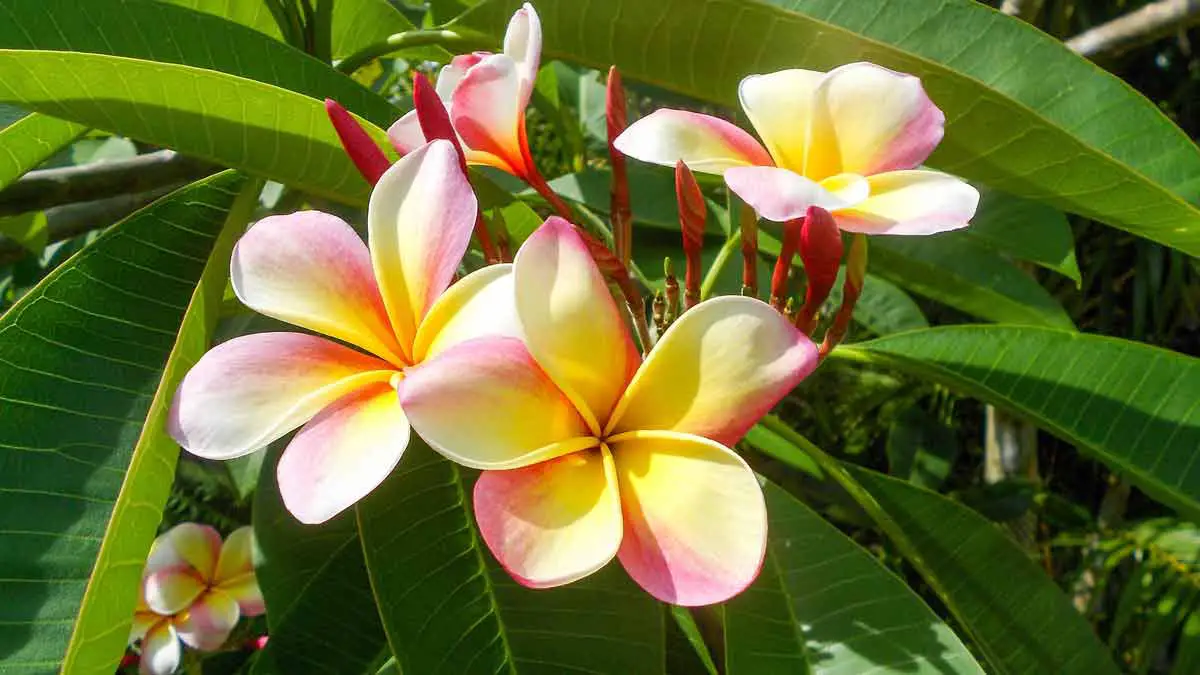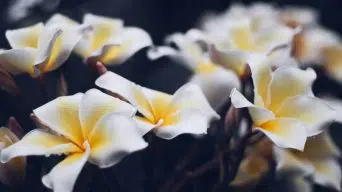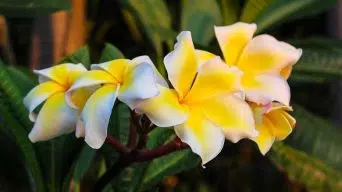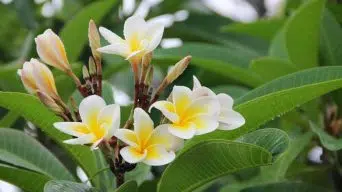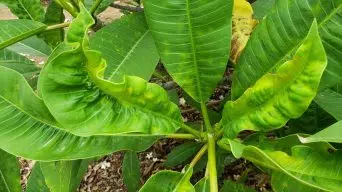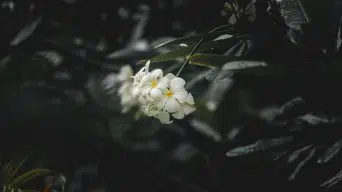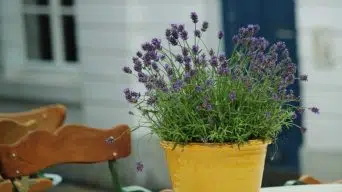To prune a plumeria, remove dead or diseased branches at any time. For shaping and size, prune in winter or early spring. To encourage growth, prune a couple of inches above the junction of two branches. Prune after the blooming period to allow the plant to put its energy into new growth.
Pruning your plumeria plants may seem like a daunting task, but with the proper guidance, it can be both rewarding and beneficial for your tropical beauties.
This guide will explain everything you need to know about pruning plumeria—from understanding their growth habits and required tools to step-by-step instructions for trimming them properly.
Understanding Plumeria Plants And Pruning
Pruning plumeria plants is a critical aspect of their care and helps to promote healthy growth and maintain their overall structure.
By pruning regularly, you can encourage the plant to produce more flowers and reduce the risk of disease or pest infestations.
To do so effectively, it’s essential to understand the benefits of pruning, the tools needed, and the optimal time to do so.
Benefits Of Pruning Plumeria Plants
Pruning plumeria plants maintain their visual appeal and promote overall plant health, resulting in a thriving and flourishing frangipani tree.
One significant benefit of pruning is that it encourages the growth of more branches, subsequently leading to an increased number of flowers.
Another advantage of regular pruning is that it helps prevent diseases and pests from spreading throughout the plant by removing dead or damaged branches.
This practice allows for better air circulation within the foliage and enables sunlight to penetrate deeper into the plant’s canopy, promoting healthy growth.
Additionally, keeping a well-maintained shape prevents unnecessary stress on the plant caused by overgrowth while ensuring proper nutrient distribution throughout each branch.
Tools Required For Pruning
Equipping yourself with the proper tools is essential when preparing to prune your plumeria plants.
Not only will having the right tools make the task more accessible and efficient, but it will also help ensure that your plant stays healthy during and after pruning.
Before starting your pruning process, remember to sanitize these tools by wiping them down with rubbing alcohol or hydrogen peroxide to minimize the risk of spreading diseases between plants.
Additionally, gardening gloves protect your hands and prevent potential infections from entering open cuts in case of accidental slips.
Best Time To Prune
Determining the best time to prune plumeria plants is crucial for promoting healthy growth and abundant flowering.
Pruning should be done in late winter or early spring, just before the new growing season begins.
In addition to promoting optimal health, pruning your plumeria during this cooler period reduces its exposure to pests and diseases that can easily infiltrate open wounds caused by cutting branches.
For instance, if you live in Southern California or other areas with mild winters, trimming during these months helps prevent frost damage to any tender new growth spurred by your efforts.
Step-by-Step Guide On How To Prune Plumeria Plants
Plumeria plants, also known as frangipani, are admired for their beautiful, fragrant flowers and tropical charm.
Pruning is a vital aspect of their care, and knowing the proper technique is essential for maintaining their health and appearance.
This step-by-step guide provides detailed instructions on how to prune plumeria plants, including assessing the plant’s condition, selecting the appropriate pruning method, and using sterile cutting tools to make clean cuts.
Whether you’re looking to shape larger trees or maintain smaller ones, this guide has got you covered.
Assessing The Plant’s Condition
Before pruning your plumeria plant, assessing its condition thoroughly is essential.
This will help you determine the extent of the pruning required and ensure that you don’t harm the plant in any way.
Start by examining the branches and leaves for signs of disease, pests, or damage.
In addition to checking for any signs of problems, look at how the plant is growing overall.
Is it too tall or lopsided? Are there too many branches crowding each other?
By identifying these issues early on and addressing them through pruning, you can encourage healthy growth and prevent further damage.
Techniques For Hard Pruning And Light Pruning
When it comes to pruning plumeria plants, there are two main techniques: hard pruning and light pruning.
Hard pruning involves cutting back the branches severely down to a main trunk or stem.
This method is best used when the plant has become too large and unwieldy or has suffered frost damage.
On the other hand, light pruning involves removing only small portions of the plant, typically just a few inches off each branch tip.
When deciding which method to use on your plumeria plant, consider its current size and condition and your desired outcome.
For example, light pruning may be the way to keep your plumeria tree small and manageable.
But hard pruning might be necessary to rejuvenate an overgrown or damaged tree.
Removing Dead Or Diseased Branches
Removing dead or diseased branches is one of the most important steps in pruning plumeria plants.
These branches can be easily identified by their brown, dry appearance and lack of new growth.
Removing these branches as soon as they’re noticed is crucial to prevent further damage or disease from spreading throughout the tree.
Removing dead or diseased branches will promote optimal growth and overall health for your plumeria plant.
This will also reduce the likelihood of pests and diseases from taking hold and causing further harm.
Regularly inspect your tree for signs of damage or disease, especially during its growing season, typically in tropical climates between late winter and early spring.
Shaping And Thinning The Plant
Shaping and thinning are two important aspects of pruning plumeria plants.
The goal is to give the plant an attractive shape while allowing light to penetrate deeper into the crown, promoting new growth on existing branches.
To shape the plant, identify where you want to make cuts.
Thinning involves removing whole stems or parts of branches from inside the canopy to create more space for air and light penetration.
This technique allows more sunlight and reduces pest and disease problems in crowded areas within your plumeria tree.
Pruning And Aftercare Tips
Plumeria plants are prized for their stunning flowers and pleasant fragrance.
Pruning is a crucial step that should not be overlooked to maintain their health and beauty.
After pruning, it’s essential to take proper aftercare measures, including sealing the cuts with lime paste to prevent damage and remove any diseased branches.
Regular fertilization and watering are also essential to promote healthy growth.
With these pruning and aftercare tips, you can keep your plumeria plants thriving and vibrant.
Sealing Cuts To Prevent Damage
When pruning plumeria plants, properly seal the cuts to prevent damage and protect them from pests and diseases.
Leaving open wounds can lead to water penetration, which may cause rot and encourage bacterial infections.
In addition to preventing damage, sealing cuts promote faster healing by reducing moisture loss and blocking pathogens from entering the wound.
When using a lime-based paste, make sure not to apply it too thickly, as this can smother the plant tissue.
Removing Diseased Branches
One of the essential steps in pruning plumeria plants is removing any diseased or dead branches.
These branches can become a breeding ground for pests and diseases, which can then spread to other parts of the plant.
When assessing your plumeria plant for pruning, look for any soft, black, or brown spots on its leaves or stems.
If you find such areas, use sharp pruning shears to cut them off completely.
After removing infected branches from your plumeria plant, it’s important not to leave any stubs behind, as they could inhibit proper healing and encourage further disease progression.
Seal all cuts with wax (like a lime paste) immediately after cutting to prevent pests and infections from entering through the wound.
Fertilizing And Watering After Pruning
After pruning your plumeria plant, providing it with the proper nutrients and water is essential to encourage healthy growth.
Fertilize the plant with a balanced fertilizer, such as a 10-30-10 formula, at half-strength for two weeks after pruning, then resume regular fertilization.
Water the plant deeply but infrequently, allowing the soil to dry out slightly between waterings.
Monitoring your plumeria plant for signs of stress or disease after pruning is also essential.
Look for yellowing leaves, wilting branches, or fungal growth around cut areas.
If you notice any of these symptoms or suspect that your plumeria may be affected by pests such as spider mites, take corrective action immediately.
Keeping Plumeria Trees Small And Manageable
Regular pruning is essential to keep your plumeria trees small and manageable.
Removing unwanted branches can direct the plant’s energy towards producing new growth in desirable areas, resulting in a more compact tree that fits easily into small spaces.
Potted plumerias benefit the most from regular pruning as their roots are confined to a container, and when left unpruned, they tend to become excessively tall and lanky.
It’s important not to over-prune your plumeria tree as it can lead to stunted growth or even death of the plant.
A good rule of thumb when cutting is never to remove more than one-third of the plant’s total foliage at one time.
If you’re unsure how much you should prune during each session or which parts of the tree should be removed, consult an expert gardener familiar with growing tropical plants like plumerias.
Common Mistakes To Avoid And Additional Tips
Plumeria plants are renowned for their vibrant and fragrant flowers.
However, caring for these plants requires precision and careful attention to pruning techniques.
To ensure your plumeria plant thrives, avoiding common mistakes such as over-pruning or under-pruning is crucial.
Additionally, it’s important to sterilize your pruning tools between cuts and only apply wound sealant when necessary.
Follow these tips to keep your plumeria plant healthy and thriving.
Applying Wound Sealant And Sterilizing Pruning Tools
To prevent the spread of infections, applying wound sealant to the cut ends of the branches after pruning your Plumeria plant is crucial.
The sealant is a protective layer that prevents bacteria and fungi from entering open wounds.
Additionally, sterilizing pruning tools is vital to avoid introducing diseases into healthy parts of your plant when making cuts.
It’s recommended to clean your shears or knife between each cut with rubbing alcohol, hydrogen peroxide, or a bleach solution to kill any fungi or bacteria that might be present on the blades.
Over-pruning And Under-pruning
Under or over-pruning are common mistakes that can harm the growth and health of Plumeria plants.
Over-pruning involves removing too many branches, which may result in stunted growth or even plant death.
To avoid these problems, it is important to strike a balance between hard pruning and light pruning.
Hard pruning should only be done every few years or when necessary to control the size of the tree.
On the other hand, light pruning can be done annually during late winter or early spring before new growth appears.
Protecting Plumeria Plants From Pests And Diseases
Pests and diseases can quickly damage plumeria plants if not adequately protected.
One of the most common insects that attack plumeria plants is spider mites, which cause yellowing leaves and webbing on the plant.
To prevent this problem, spray your plant with water and neem oil once weekly during the growing season.
Additionally, you should inspect your plant regularly for any signs of disease or infection, such as powdery mildew.
Another important aspect to consider in protecting your plumeria from pests and diseases is proper soil drainage since root rot can also be a significant threat to these tropical plants.
Ensure your plumeria has excellent soil drainage by planting it in a well-draining potting mix.
Avoid overwatering the plumeria plant during its dormant period in late fall and winter, when it’s more susceptible to frost damage due to wet roots.
Additional Tips For Growing Healthy Plumeria Plants
To ensure the growth and health of your plumeria plants, there are a few additional tips to keep in mind.
First, ensure your plant gets enough sunlight, as this tropical plant thrives in full sun exposure.
Another critical factor in plumeria care is fertilization.
Apply fertilizer every three months during the growing season for better flower production.
Finally, be aware of common pests like spider mites affecting plumeria plants.
Final Thoughts
Pruning plumeria plants may seem daunting at first, but with this complete guide, it can be a straightforward process.
Remember to prune in the early spring for best results and to use sharp and sterile pruning tools to avoid damage or infection.
Removing dead or diseased branches and shaping the plant can encourage healthy growth and beautiful blooms.
Ensure proper aftercare by sealing cuts, fertilizing, watering when necessary, and protecting your plumeria from pests and diseases.

